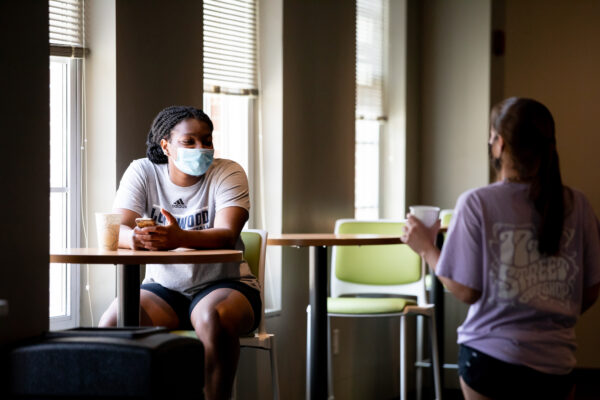The phone call was bracing, to say the least. One of the more energizing parts of my job is talking regularly to college and university leaders around the world about the most pressing issues facing higher education. But this conversation was different.
I could hear and feel the distress in the president’s voice: “Summer school enrollment is already under siege and the strong numbers we once anticipated for the fall semester are in danger of plummeting in the blink of an eye.” He went on to describe that efforts to improve efficiencies and manage cash flow were already underway. Furloughs, voluntary administrative salary reductions, and other dire budget changes were next. As he explained, the low-hanging fruit are disappearing quickly and the campus is settling in for a long financial journey as it battles COVID-19. And the data certainly confirm this campus official is not alone.
This past week, ACE released the results of a poll of college and university presidents that asked about their most significant challenges during the pandemic.[1] Across all sectors, presidents most commonly selected “fall or summer enrollment numbers” and “long-term financial viability.”
These numbers aren’t surprising. In the wake of COVID-19, colleges and universities across the country are making decisions about issuing refunds for room and board, freezing hiring, and other immediate financial measures. Tellingly, some institutions aren’t able to offer a refund, like one small college that plainly stated it is “not in a financial position to offer any rebates on housing or meal plans.” Every campus, whether the losses are in the millions or tens of millions, is struggling with these trade offs.
In writing about COVID-19, Scott Cowen, president emeritus of Tulane University, recalled a difficult realization during the Katrina disaster in 2005: “I knew in my heart that Tulane could not realistically go back to the way it was prior to the hurricane.”
I think everyone in higher education is having a similar realization right now.
How can we continue to lead when the future is so uncertain? In that same article, Cowen mentions adaptive leadership[2] as a way to step outside to see the crisis clearly. True, adaptive leadership can offer an excellent perspective on the situation. But we take it further: adaptive leadership, at its best, is when different stakeholders lean in to make decisions and solve problems as a collective unit, particularly during a crisis.
And starting now, how we make decisions will matter more than ever because the choices are about to get much more difficult. In our survey, nearly two-thirds of presidents indicated that they had already begun identifying efficiency and cost-control measures, like staff-hiring freezes. Virtually all of the rest of presidents polled said they anticipate taking such action in the future: 57 percent say they anticipate laying off staff, 49 percent anticipate merging or eliminating academic programs, and 32 percent anticipate laying off faculty.
In the short term, actions like a hiring freeze are the obvious—and much needed—efforts. But these actions are technical in nature, meaning there is little nuance in their execution. However, the challenge ahead of us isn’t technical; it is complicated, amorphous, and unclear. An ever-changing problem needs adaptive leadership. Unlike top-down approaches to leadership, adaptive leadership asks that both the leader and institutional stakeholders—such as faculty, staff, students, administrators, board members, and others—accept shared responsibility for the outcome, even when their perspectives differ.
This can often feel like a no-win game, as someone is always going to be unhappy with some aspect of a decision. But that’s when you know you’re doing it correctly.
Instead of looking for the simplest solution to the immediate problem, adaptive leadership looks for the most sustainable solution for the long term. The Great Recession in 2008, while certainly not of the magnitude we are likely to face in this crisis, represents a challenging time from which we can draw important lessons on managing fiscal distress in higher education.
I conducted research during that period on the financial strategies institutions leveraged to respond to that budget crisis. At the same time, I lived the experience as a member of the executive leadership team at a large public university. We faced an uphill battle at our institution, with a budget loss of more than $100 million over three years. This was an adaptive problem that required adaptive solutions. Sure, we applied some technical budget management fixes on the front end of the crisis to stay afloat, but the real work began when we needed a long-term sustainability strategy to help us emerge (as my colleague and Penn Professor Bob Zemsky often says) in a “market-smart, mission-centered” position.
In collaboration with university stakeholders, we developed a framework for resource allocation to navigate the sustained period of change and transformation. It included a wide array of strategies, such as protecting the most critical strategic priorities from cuts, investing in academic programs that were regional economic engines, and in some areas, making painful reductions or business model changes to ensure we emerged stronger and more strategically positioned for the future. It certainly wasn’t easy, and here’s why:
As with any effort to drive institutional transformation, but especially one involving precious campus resources, the question becomes how to galvanize the community to act on these priorities. It’s often lamented that strategic plans go on the shelf in the best of times. Getting multiple stakeholders to come together to make tough decisions based on strategic priorities is no small feat, particularly if a given priority works against their own interests. To engage in adaptive work, leaders must embrace a healthy and contained period of disequilibrium, or manageable conflict, in the organization. In other words, all stakeholders need to share the uncertainty of the moment to fully understand that things can’t go back to how they used to be.
When campus stakeholders realize that not all problems will be solved by straightforward fixes from the administration, they are in a better position to speak about their values and initiate adaptive change. The creator of the concept of adaptive leadership, Ronald Heifetz, warns that organizations “fail to adapt when its people look to their authorities to meet challenges that require changes in their own ways.”[3] In other words, stakeholders must realize that not only do they need to act, but that they have a responsibility to act. Their perspectives and values can inform a sustainable vision for the institution, and the most innovative solutions will emerge from their competing values.
Yes, this approach sounds very Team of Rivals. But by generating some manageable conflict, an adaptive leader can motivate people to change their mindset. Without the disequilibrium, long-term cultural and financial challenges can be ignored and change averted.
Use the current uncertainty to effect real change by giving the work back to the people. Leadership in an academic setting, especially during fiscal distress, requires compromise and composure for a successful outcome. ACE’s model of institutional transformation embraces eight core principles:
- Begin with institutional mission and values as the framework for change.
- Promote and empower a shared leadership model.
- Engage the campus in dialogue to develop a shared vision.
- Employ data-driven analysis of existing assets, needs, capabilities, and opportunities.
- Establish priorities, plans, and assessment metrics for both the immediate and long-term.
- Apply a student-centric lens and emphasize financial sustainability from conceptualization through implementation.
- Commit to continual improvement and on-going assessment, remaining ready to adapt to emerging circumstances.
- Engender deep and integrated organizational and cultural change over time
The challenge ahead for higher education is unprecedented, and the typical solutions won’t sustain our institutions. As a community of learners, thinkers, and problem solvers, let’s unite around the tough decisions ahead of us, bringing our collective perspectives and values to the table. If we can’t go back to what we used to be before COVID-19, we must instead evolve to something better.
[1] The survey collected responses from 192 presidents. Of the 192 presidents, 41 lead public four-year institutions (21 percent), 107 lead private four-year institutions (56 percent), 33 lead public two-year institutions (17 percent), 5 lead private two-year institutions (3 percent), and 6 lead for-profit institutions (3 percent).
[2] The concept of adaptive leadership was developed by Ronald Heifetz, founding director of the Center on Public Leadership at Harvard’s Kennedy School of Government.
[3] Heifetz, Ronald. Leadership Without Easy Answers. 1994. p. 262.
If you have any questions or comments about this blog post, please contact us.



